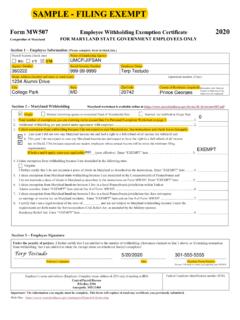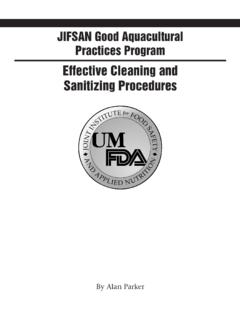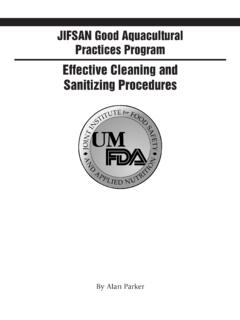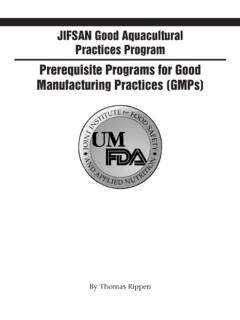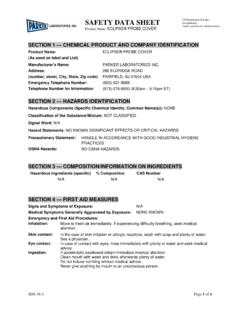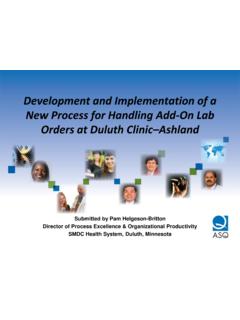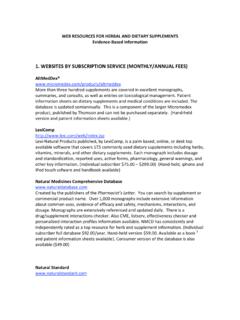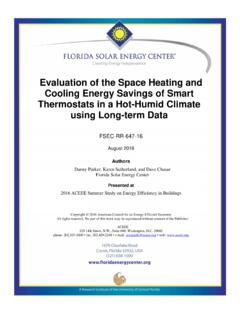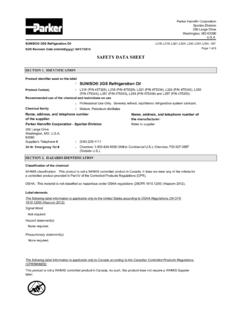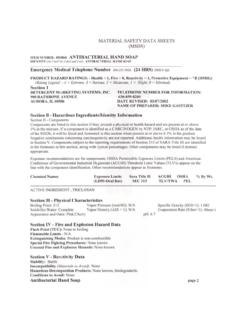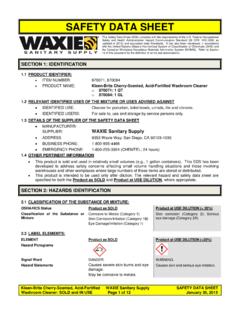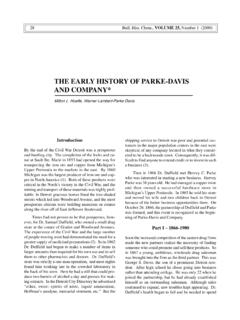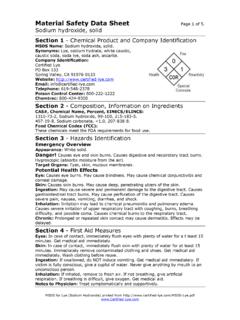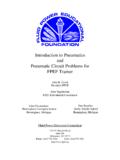Transcription of Effective Cleaning and Sanitizing Procedures - JIFSAN
1 JIFSAN Good Aquacultural Practices ProgramEffective Cleaning and Sanitizing ProceduresBy Alan ParkerWhy Is Effective Cleaning and Sanitizing So Important? Effective Cleaning and Sanitizing helps protect the health of the animals by controlling the transmission of animal diseases. It controls human health by preventing transmission of human diseases in foods. Cleaning and Sanitizing helps prevent pest infestations by reducing residues that can attract and support pests. It also improves the shelf life and sensory quality of food Cleaning and Sanitizing Effective Cleaning and Sanitizing is done by identifying areas and items to be cleaned. Then, Effective chemicals and application methods must be selected. Clean is competed first, then Sanitizing is done in 2 steps.
2 You should perform CandS regularly, and validate that the program has been performed Should be Cleaned and Sanitized?All surfaces that may contact the food product , such as utensils, knives, tables, cutting boards, conveyor belts, ice makers, ice storage bins, hands, gloves, and aprons. Surfaces that do not directly contact the product such as walls, ceilings, floors and drains have a profound effect on Else Should be Cleaned and Sanitized? Cleaning tools like brooms, mops, squeegees, buckets, sponges, scrapers, foaming equipment, water guns, etc., should be cleaned and sanitized. Cleaning tools can be a major source of microbial contamination if not cleaned. Cleaning tools should be washed and sanitized after every use. They should be stored clean, dried, and Cleaning StepCleaning is the complete removal of unwanted matter using appropriate detergent chemicals under JIFSAN Good Aquacultural Practices Manual Section 9 Effective Cleaning and Sanitizing Proceduresrecommended conditions.
3 Cleaning personnel need a working understanding of the type of substances to be cleaned the basic chemistry of its removal. As we will see later, Cleaning and Sanitizing need to be performed in two separate steps. It is impossible to sanitize a surface that is still dirty. There must be an Effective rinse after the Cleaning step to remove detergent residue that can interfere with the action of chemical of Food Soils Soil is any unwanted matter on the surface of an object that one desires to be clean. Cleanliness is an unnatural condition, because all surfaces are constantly being soiled. Special care must be taken to ensure that all soil is removed and that it is not redeposited on the substrate. Soil may be classified as visible and invisible, the latter category being primarily microorganisms, such as bacteria, yeasts, and molds.
4 Soil is best identified by characteristics that give information on how it may be dissolved, because the object of Cleaning is to dissolve or to suspend soil and then to wash it food soils can be dissolved in water such as simple carbohydrates (sugars), some simple mineral salts (NaCl), and some starches. There are also food soils that dissolve in alkali, like proteins, starches associated with proteins or fats, and bacterial films (biofilms). There are food soils that dissolve in acid, like hard water hardness salts (calcium and magnesium salts), and more complex mineral films, including iron and manganese deposits. Finally, there are those that dissolve with surfactants, which include fats, oils and greases, many food residues, inert soils such as sand, clay, or fine metals, and some are Biofilms?
5 Biofilms are a collection of microorganisms, mainly bacteria, growing together in a matrix of polymers secreted by the microorganisms. Once microbes Copyright 2007 University of Maryland and the JohnsonDiversey Corporation. This work may be reproduced and redistributed, in whole or in part, without alteration and without prior written permission, for nonprofit administrative or educational purposes provided all copies contain the following statement: 2007 University of Maryland and the JohnsonDiversey This work is reproduced and distributed with the permission of the University of Maryland. No other use is permitted without express prior written permission. For permission, contact JIFSAN , University of Maryland, Symons Hall, College Park, MD grow into well-developed biofilms, Cleaning and sanitation become much more difficult.
6 Biofilms have a shielding effect on the bacterial cells within them, and normal Cleaning and Sanitizing methods may not eliminate them. Biofilms MUST be removed or prevented from forming on surfaces. Disease-producing bacteria, including Listeria, can be 1,000 times harder to eliminate if it is living in a protective biofilm. Biofilms can be very difficult to remove from surfaces, and are known to have an increased biocidal resistance due to the biofilm structure protecting the microorganisms. Biofilms can be a continual source of pathogenic and spoilage organisms if not completely are Biofilms?A collection of microorganisms, mainly bacteria,growing together in a matrix of polymerssecreted by the MSUC enter forBio lmEngineeringBULKFLUIDA ttachmentColonizationGrowthBiofilm Formation:Planktonic CellsSessile CellsS U R F A C E M S U - C B EP.
7 D i r c k xSpoilage organisms such as Pseudomonas grow in biofilms and can be sloughed off during production, contaminate the food, and accelerate spoilage. The polymers secreted by the bacteria close to the surface are strong adhesives making the cells very difficult to remove. The cells in a biofilm actually take on specialized functions and can communicate with each other in a rudimentary way (called Quorum Sensing).Water Called the universal solvent, water is the basis for all surface cleaners. Water is a good solvent by itself it has the ability to clean many soiled surfaces. Cleaning with water alone is the yardstick by which we measure the effect of Cleaning chemicals. Other active ingredients are added to enhance the effect. Detergents aid water in removing Make Water Wetter A surfactant (surface active agent) is a substance that lowers the surface tension of a solution.
8 Surfactants also foam, emulsify, and disperse soils in solution. Surfactants have anionic, cationic. or nonionic (neutral) chemical Cleaning FunctionWater comprises approximately 95-99% of Cleaning solutionsWater s many functions in Cleaning :Pre-rinse, to remove gross soilsSoften soils left on the surfaceCarry detergent to the surface to be cleanedCarry wastes away from the surface being cleanedRinse detergent off of the surfaceWater quality, particularly its mineral hardness, can drastically alter the effectiveness of a HardnessSurface CleanersWater AloneOrganic soilNo wetting of soils on surfaceWater + SurfactantSolid substrateSolid substrateSoilwithinwaterdropletWETTED SOILW ettingoccurringwithwater plussurfactantCopyright 2007 University of Maryland and the JohnsonDiversey Copyright 2007 University of Maryland and the JohnsonDiversey or Cleaning AgentBoth soaps and detergents help water to emulsify fats and to suspend solid soil particles.
9 Soaps are made from fats and lye, while detergents are synthetic chemicals. Soaps and detergents act by reducing the surface tension of water, which increases water s interaction with soils, surrounds and lifts the soil from the surface, and allows water to flush the surrounded soils away. Proteins will hydrate and swell when they come into contact with water, which helps alkalis to react with them, forming soluble of CleanersManual Cleaning Equipment manually disassembled Hand scrubbing and washing Semi-automatic OPC High pressure washing and rinsing FoamingMechanical (Clean-in-place or CIP) Automated Cleaning processManual Cleaning Pads, brushes and brooms should be:1. Dedicated to tasks for which they are designed. Optimizes Cleaning effectiveness; and Minimizes cross-contamination between areas of the Designed for the task.
10 Brushes proper stiffness; Pads proper cutting properties; and Pressure spray moderate pressure. Cleaning aids that retain water, such as sponges, wiping cloths, and mops should not be used for routine Do not mix uses. For example, never: Use floor brooms / floor squeegees on tables Use green pads used for Cleaning waste barrels on grading or packing tables Use the same brush to clean floors on any food contact surface. High Pressure Washing Useful for walls, floors, large equipment and tables. Spray can form aerosols mist from irritating chemicals. Atomization can spread soil and microorganisms. Pressures used: Low Pressure: <15 bar Medium Pressure: 15 to 3 barCharacteristics of a Good DetergentRapid and complete solubility in waterGood swelling of soilGood wetting capability of surfacesGood dispersion and suspension propertiesGood rinsing propertiesNon-corrosive to surfacesNon-toxicCost effectiveDailyAlkalineConcreteFloorsDail yModerately alkalinesubstancesGlassDailyAlkaline SubstancesRubberDailyDetergents withsurfactantsWoodDailyModerately alkalinesubstanceswithcorrosioninhibitor sMetals (copper,aluminum,galvanizedsurfaces)Dail yWeeklyAlkaline,not abrasiveAcid, not abrasiveStainlesssteelFREQUENCYOF USERECOMMENDEDCLEANING SUBSTANCETYPE OFSURFACES urfaces and Cleaning Substances9- Copyright 2007 University of Maryland and the JohnsonDiversey Corporation.
